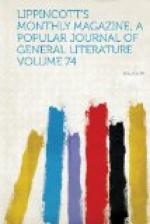The monsoon was favorable, and seven days’ sail brought us to the river’s mouth, and a pull thence of thirty miles in the narcodah’s boat to the “city of kings.”
Siam is verily the queen of the tropics in regard to the abundance, variety and unequaled lusciousness of her fruits. Here are found those of China, greatly enriched in tint and flavor by being transplanted to this warmer climate; and those of Western Asia, in this fruitful soil far more productive than in the sterile regions of Persia and Arabia; while numberless varieties from the Malayan and Indian archipelagoes, united with the host of those indigenous to the country, complete a list of some two hundred or more species of edible fruits. In this clime of perennial freshness trees bear nearly the year round, and so productive is the soil that the annual produce is almost incredible. The tax on orchards alone yields to the Crown a revenue of some five millions of dollars per annum, as I was informed by the late “second king” of Siam. It is not unusual to find on a single branch the bud and blossom, together with fruit in several different stages. Thus, at the merest trifle of expense a table may be supplied during the entire year with forty or fifty specimens of fresh, ripe fruit. Among these are many varieties of oranges and pineapples, pumeloes, shaddocks, pawpaws, guavas, bananas, plantains, durians, jack-fruit, melons, grapes, mangoes, cocoa-nuts, pomegranates, soursaps, linchies, custard-apples, breadfruit, cassew-nuts, plums, tamarinds, mangosteens, rambustans, and scores of others for which we have no names in our language. Tropical fruits are generally juicy, sweet with a slight admixture of acid, luscious, and peculiarly agreeable in a warm climate; and when partaken of with temperance and due regard to quality they are highly promotive of health. For this reason Booddhists regard the destruction of a fruit tree as quite an act of sacrilege, and their sacred books pronounce a heavy malediction on those who wantonly commit so great a crime. One who has tasted the fruits of the tropics only at a distance from the soil that produces them can form no conception of the real flavor of plums and grapes that never felt the frosty atmosphere of our northern clime; of oranges plucked ripe from the fragrant stem and eaten fresh while the morning dew still glitters on their golden-tinted cheeks; of the rare, rosy pomegranate juice, luscious as nectar.
After eating the fruits of all climes, I place the mangosteen at the head of the list as absolutely perfect in flavor and fragrance. The fruit is spherical in form, about the size of a small orange, of a rich crimson-purple hue without, and filled with a succulent, half-transparent pulp that melts in the mouth. There are three species of the mangosteen tree, but of only one, the Garania mangostina, is the fruit edible. The others are valuable for timber, and the bark for the manufacture of a dye that resists the attacks of every sort of insect.




